BELARUS
History

History
Cities in BELARUS
| Minsk |
History
Antiquity and Middle Ages
Archaeologists have discovered settlements dating back to 10,000 years, the Neolithic period. In the 5th century BC. the first BelaRussians settled in the forest plains near the Pripyat River.
The areas of present-day Belarus were already inhabited by Slavic tribes at the beginning of our era. At the end of the 9th century, a number of East Slavic tribes, including Polochans and Krivitsjen, lived on what is now Belarusian territory. During this time the empire of Kiev-Russia was also established here, under the leadership of the Rurikids.
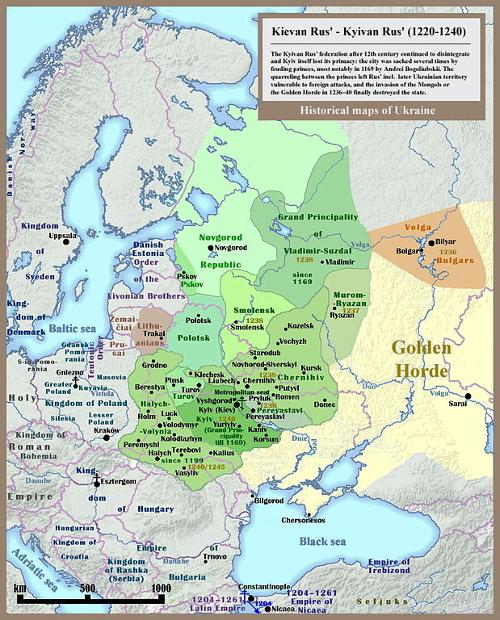 Map Kiev RussiaPhoto: SeikioEn CrC 3.0 Unported no changes made
Map Kiev RussiaPhoto: SeikioEn CrC 3.0 Unported no changes made
Under the rule of this people the tribal structure came to an end, which was replaced by a number of sub-principalities, of which that of Polotsk became the most important.
The fragmentation of power continued into the 13th century, as a result of which Belraussian territory was easily conquered by the Lithuanian Gedyminas (1315-1340). After the union of Lithuania and Poland in 1569, present-day Belarus came under increasing influence of Western civilization and further and further away from Russian civilization. At this time the area on the Upper Dnieper was called Belarus, the area south of the Neman River was called Black Russia for a long time.
Belarus is part of the Russian Empire
At the end of the 18th century Belarus came to Russia through the so-called Polish divisions. However, strong national sentiments prevented Belarus from being Russified. This was also evident after the Russian Revolution of 1905, when the Belorussian Socialist Republic (Byelorushaya Sotsjalistitseskaya Hramada) retained its cultural autonomy. After the October Revolution of 1917, Belarus was considered a separate nation by the Bolsheviks and was given the right to self-determination.
Belarus part of the Soviet Union
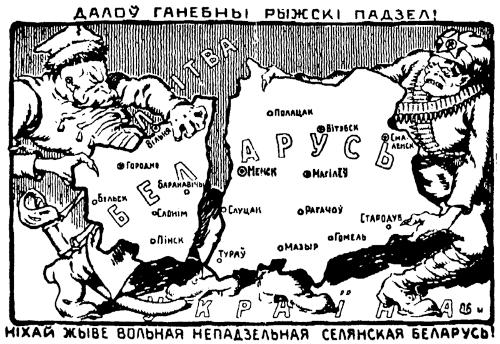 Caricature for the Peace of RigaPhoto: Public domain
Caricature for the Peace of RigaPhoto: Public domain
After the Peace of Riga in 1920, the western part of Belarus was transferred to Poland. What remained of Belarusian territory became a state of the Soviet Union in 1922 with the official name Belaruskaya Sovetskaya Sochialistichnaja Respublika (or BSSR). After the Russian invasion of Poland, Belarus regained its territories, only to lose them to Poland after the Second World War. Belarus initially seemed to side with the Germans during World War II, but after quarrels with the German rulers, a motley variety of partisan groups emerged that opposed the Germans. Meanwhile, the population suffered greatly from the brutal rule of the Germans.
In the summer of 1944, the Germans were expelled from Belarus and the country became a full member state of the Soviet Union again. It was remarkable that when the United Nations was established in 1945, Belarus was allowed to become a full member, despite a foreign policy determined by the Soviet Union.
Independence
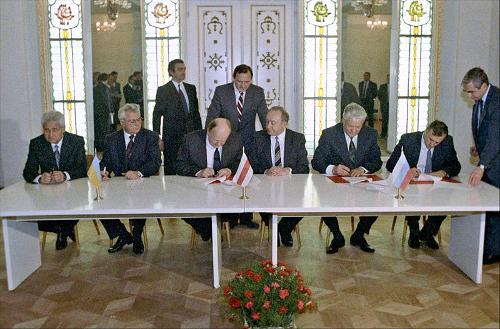 Signing of the dissolution of USSR in BelarusPhoto: RIA Novosti archive, image #848095 / U. Ivanov CC-BY-SA 3.0 no changes made
Signing of the dissolution of USSR in BelarusPhoto: RIA Novosti archive, image #848095 / U. Ivanov CC-BY-SA 3.0 no changes made
In the late 1980s, the Soviet Union slowly lost its grip on the many member states. Nationalism flourished everywhere and on July 27, 1990, Belarus declared itself a sovereign state. On August 25, 1991, Belarus declared its independence and in December 1991 it formed the Commonwealth of Independent States (CIS) with Ukraine and the Russian Federation.
The first presidential elections were held in June 1994 and eventually won by Aleksandr Lukashenko, who chaired the parliamentary anti-corruption committee at the time. In July, the Kebich government resigned and the new prime minister became the economic reformer Michael Chigir. However, the transition to a market economy was very difficult and 1994 ended with declining industrial production, gigantic inflation and a sharply declining standard of living. In addition, the Belarusian Parliament fiercely opposed the government's privatization program.
In May 1995, a referendum was held in which Lukashenko gained more and more power. He even received support for possibly dissolving the parliament and again strived for integration with Russia.
Lukashenko now ruled by decree and even dismissed some of the Supreme Court rulings that he did not like. As a result, it was still possible for him to promulgate, amend and repeal laws. The economy, which was almost entirely dependent on Russia, was in a deplorable condition, partly due to the high energy debts to that same country.
In 1996, Lukashenko finally got what he wanted. In a new referendum, a new constitution was approved, extending the powers of the president to the maximum: he could dissolve parliament on his own. It will come as no surprise that this situation arose almost immediately and that the new parliament consisted only of Lukashenko adepts. His term of office was also extended to 2001, and in April 1996 a much-desired "economic reintegration community" with Russia was established, which, however, was of little consequence. Although the opposition was stirring, Lukashenko could still count on a majority of the population despite everything. Internationally, Belarus became increasingly isolated as a result of all these anti-democratic measures.
In December 1998, Lukashenko and Russian President Yeltsin signed an agreement to establish a common state, while preserving everyone's sovereignty. At the end of December, Yeltsin and Lukashenko signed another treaty, but this treaty too did not amount to much in practice due to the wait-and-see attitude of the new Russian president Putin.
In May 1999, all opposition parties organized new presidential elections when Lukashenko's term expired. According to Lukashenko, under the constitution it was possible to extend the term of office and he therefore opposed the elections. Newspapers were in fact censored because they were not allowed to write about the elections and political parties were also prohibited from participating in the elections. The Electoral Commission then decided to declare the elections invalid, which further exacerbated the division among the opposition parties.
21th century
In March 2000, Sergej Ling was succeeded as Prime Minister by Uladzimir Yarmoshyn and demonstrations against Lukashenko followed. Hundreds of protesters were arrested and sentenced to prison terms.
Parliamentary elections were held in October, but were boycotted by a large part of the opposition. Lukashenko's undemocratic behavior was also strongly criticized abroad. The economy continued to suffer in 2000 with a high inflation rate and low wages. On September 9, 2001, the presidential elections were won by great force (76.5% of the votes) by Lukashenko. The opposition demanded a second round, but this appeal was not successful due to the great support Lukashenko had among the population. Despite much criticism from, among others, the OSCE, the election results were accepted abroad.
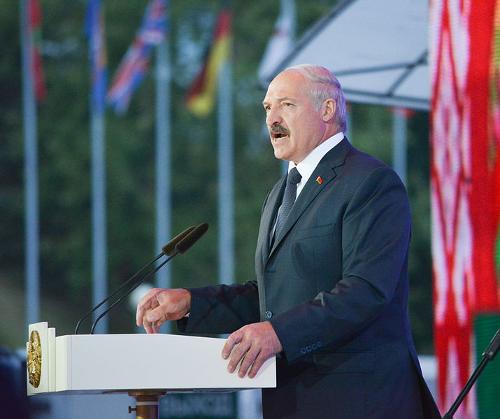 Lukashenko BelarusPhoto: Okras CC 4.0 International no changes made
Lukashenko BelarusPhoto: Okras CC 4.0 International no changes made
At the end of December, Lukashenko proposed to Putin a new joint constitution, but the Russians did not speak up. The human rights situation in Belarus was increasingly criticized from abroad, leading to further isolation of President Lukashenko. President Putin of Russia proposed to fully integrate Belarus into the Russian Federation by adopting the Russian constitution, currency and language and appointing a head of state. Lukashenko indignantly rejected the proposal.
The economy deteriorated even further in 2002. This cost Lukashenko some of its popularity. The European Bank for Reconstruction and Development suspended all activities in Belarus and the IMF also strongly criticized Lukashenko's economic policy and stated that it would no longer grant loans. To make matters worse, Russia threatened to stop the supply of natural gas due to non-payments. New facts about "freedom" of speech emerged; for example, television was placed under full state control. In July, Lukashenko fired two ministers over wage arrears in the agricultural sector.
The economy continued to be a source of concern in 2003 as well. Half of all companies suffered losses, inflation soared and over 40% of Belarusians lived below the poverty line.
The ongoing privatization was reversed and many companies were brought back under full state control. The main parties are the Communist Party of Belarus and the Agrarian Party, both of which support the president. Many seats are further won by independent candidates. In the 2004 parliamentary elections pro-Lukashenko candidates won every seat, after much of the opposition was disqualified for technical reasons. These elections were qualified as undemocratic by international observers.
For the presidential election in March 2006, the united opposition met with a joint candidate, Alexander Milinkevich. Another opposition candidate, Kozulin, also took part in the elections. In the run-up to these elections, as in previous years, the opposition was hampered by government intimidation and lack of access to state media. Important opposition parties are the Belarusian Popular Front, the United Civic Party, the Belarusian Social Democratic Party and Hramada. Milinkevich officially received only 6% of the vote, while Lukashenko officially received over 82% of the vote. Given the months of intimidation of opposition supporters and the lack of transparency in election counting, the international community has declared the presidential election neither free nor fair.
In the years 2007 and 2008 there has been a protracted conflict with Russia over gas and oil supplies. In June 2008 Belarus decides to build a nuclear power plant for which an international tender is being launched. In the September 2008 elections, government candidates win all 110 seats in parliament. In October, the EU suspends President Lukashenko's travel ban to encourage democratic reforms. In April 2009, Lukashenko visits Vatican City during his first Western European visit since 1995. Also in 2010, Russia and Belarus fought over oil and gas supplies. In January 2011, Lukashenko is sworn in as president for a fourth term. In 2011 Belarus ran into financial difficulties and struck a deal to get Russian gas cheaper. In return, Gazprom gains control of the Belarusian pipeline. In 2012 and 2013, unrest in Belarus remains and there are problems with the EU. The opposition is threatening to boycott elections. In March 2014, Belarus requested reinforcements from Russia due to the presence of additional NATO troops in the Baltic states as a result of the Ukraine crisis. In November 2015, Lukashenko won the elections again, for the fifth time, with 83.5% of the vote. In September 2016, two opposition candidates win seats in parliamentary elections, which are otherwise completely dominated by pro-government candidates. It is said that the government has arranged this. In September 2017, Belarus and Russia will hold military exercises code-named Zapad close to the borders of the NATO countries. Western experts say they are the greatest exercises since the cold war.
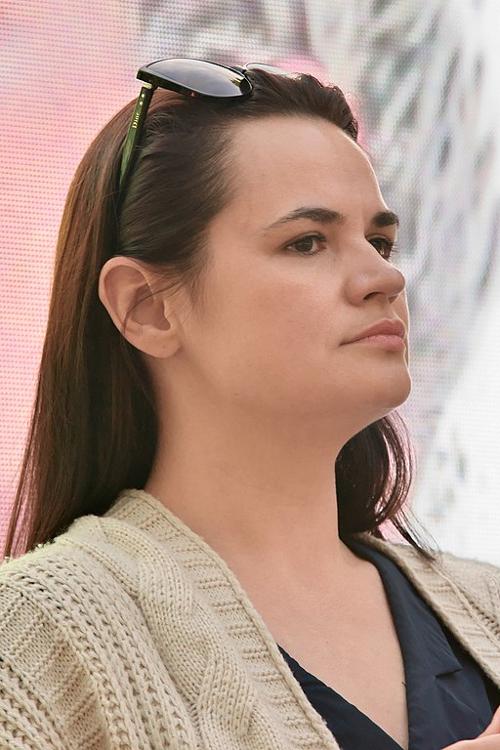 Svetlana Tichanovskaja BelarusPhoto: Serge Serebro CC 4.0 International no changes made
Svetlana Tichanovskaja BelarusPhoto: Serge Serebro CC 4.0 International no changes made
There will be elections in August 2020, in which Lukashenko would again have obtained 80% of the vote. Opposition candidate Svetlana Tichanovskaya, whose husband is in prison for political reasons, flees to Lithuania. There are massive demonstrations against Lukashenko that the riot police are cracking down on. The EU expresses its horror at this action and the fraudulent elections. Lukashenko seeks support from Putin. In 2022, the government of Belarus supports the Russian invasion of Ukraine.
Sources
Belarus
Lerner Publications Company
Belarus and Moldova : country studies
Federal Research Division, Library of Congress
Holtbrügge, D. / Weissrussland
Verlag C.H. Beck
Levy, P. / Belarus
Marshall Cavendish
Oost-Europa
The Reader’s Digest
Russia & Belarus
Lonely Planet
CIA - World Factbook
BBC - Country Profiles
Last updated December 2025Copyright: Team The World of Info